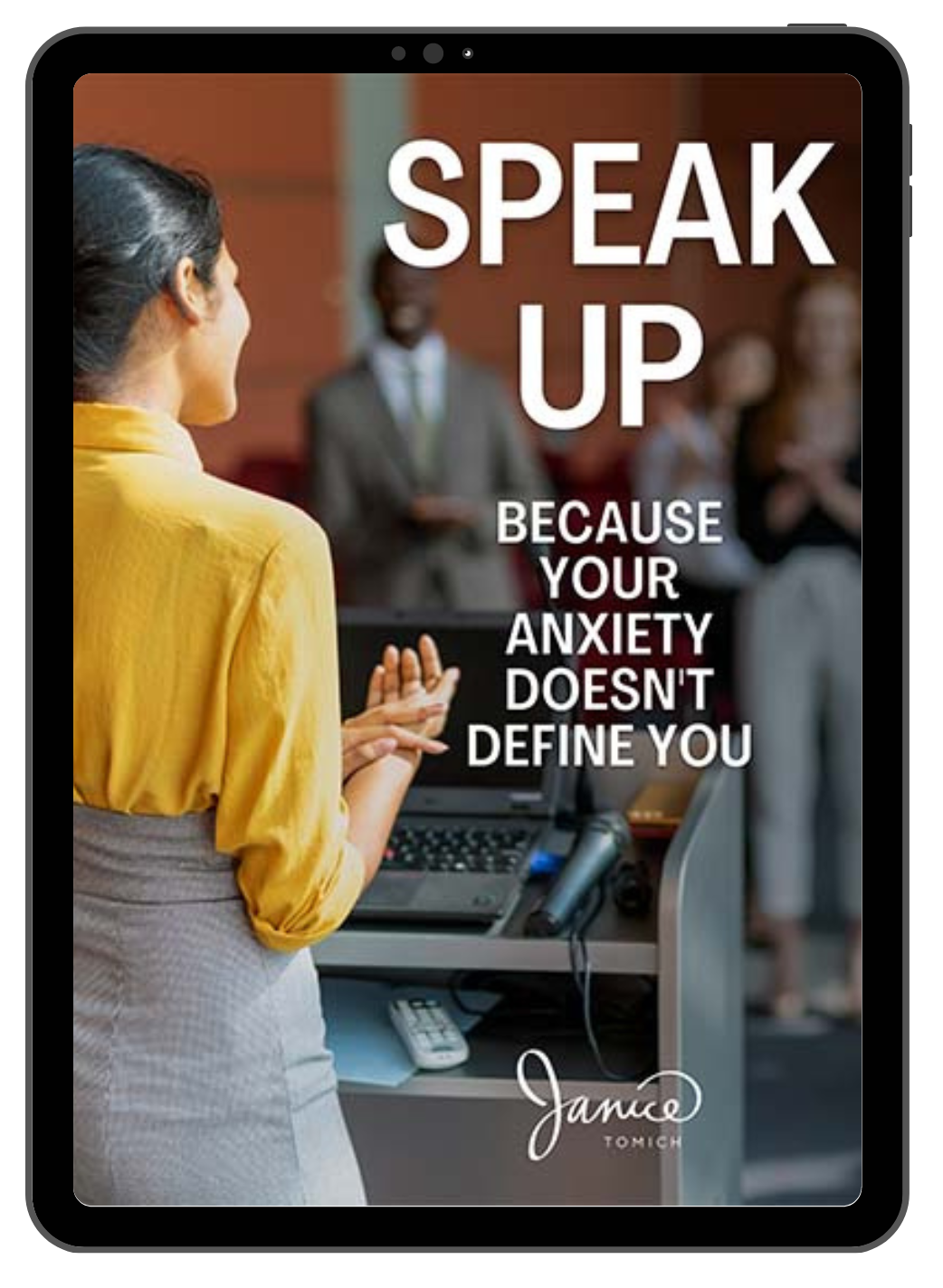Lack of public speaking confidence, whether with peers or strangers, is considered a social anxiety disorder. More people don’t want to be front and centre than do. Across the spectrum, glossophobia (fear of public speaking) touches 73% of the population.
Try to think of people who would tell you that they love public speaking. Likely you can’t come up many names. Usually, someone’s first reaction when the subject of public speaking comes up is they’d rather not. They’ll tell you about the unexplainable surge of fear they feel when they even just think about giving a presentation.
If you’re the one of many people who declines speaking opportunities (or have sleepless nights before your time to take the stage) then I think it’s fair to say that public speaking is not your favourite thing to do either.
Many professionals and executives find public speaking daunting. But as an executive communication coach, I know that speaking with confidence is attainable. For everyone.
Table of Contents
What is Public Speaking Confidence?
Public speaking confidence means no longer having sleepless nights before a big presentation. Confidence means knowing your presentation conveys an impactful message that your audience needs to hear. Once you’re confident in your public speaking skills, you’ll be able to deliver your message powerfully, with ease.
You’ll speak and be heard. That’s the goal.
How To Cultivate A Confident Mindset For Public Speaking

Awareness Is the First Step To Building Public Speaking Confidence
The first step to dropping the weight of public speaking nerves and anxiety is understanding that it’s embedded in our DNA.
In primordial times, people always lived in groups. Living alone would have left us vulnerable to the environment. If you were rejected by the group, your isolation would lead to a justifiable fear—you’d have no community or group to protect you.
Now, many centuries later, things have changed. But the same fear response remains and it can be activated by the same types of situations, or perceptions of them. For many people, standing alone to give a presentation before a group can trigger a fight or flight response. Public speaking isn’t life threatening—there is no need to be on high alert—but the reaction is deeply embedded in the human psyche.
Knowing the root reason for why you experience public speaking anxiety while delivering a presentation or speech (or even while thinking about it) is the first step to mastering confident public speaking.
The next step is to work on your mindset.
If you’re feeling unheard or misunderstood, I can help.
Switch Perspective To Create A Positive, Confident Mindset
Focus On Your Audience, Not Yourself
Strong leaders are those who inhabit a position of “being of service.” Strong leaders focus on giving, supporting, and mentoring and this is what allows them to leave a legacy of success.
This same concept of “being of service” applies to your ability to speak confidently. Public speakers are often very self-focussed. They think it’s about them and what they know. That they’re being measured, being judged. But nothing could be further from the truth.
Shifting you focus from yourself to others and fully believing your speech is about those you serve (not about you) puts you on a solid foundation to learning how to be a confident public speaker. While creating and developing your presentation, put yourself in your audience’s shoes. What’s in it for them?
A simple technique to start connecting with your audience better in the speech itself is to direct the content to point at them. You can use phrasing such as “This is something you’ve probably experienced” or “Have you noticed…?”
Most people who gather to listen to your presentation or speech are on your side. They would not be investing their time to attend if they weren’t rooting for you and believe that what you have to say will benefit them. One caveat, of course, is that you will never be able to please everyone. (That’s a perfectionist perspective and it’s unattainable.)
Pro Tip: Increase your comfort level (and your confidence) when you arrive at your speaking event by reaching out and introducing yourself to others. Find out why they decided to attend the event. It’ll be easier to create an interactive presentation when you know who’s in the room and what they want to learn from you.
Focus On The Message You Want To Send
Take the time to learn what your audience wants to hear.
Your audience wants to learn from you and pull nuggets of information they can use themselves or take back to their team(s).
Practically speaking, one way to do this is to use a whiteboard and brainstorm what you think your audience wants to learn from you. For inspiration, think about questions that colleagues or clients have asked you. Check out online discussion forums like Quora or Reddit, which can provide insights into what questions are being asked.
Consider too that audiences can differ in how they learn best. How can you deliver your message in a way that they can easily understand? So that they can run with your ideas and implement them into their lives?
Too often, we think that public speaking confidence is something we either have or we don’t and that it’s unrelated to the contents of your speech, your core message. The truth is that you’ll feel far more confident public speaking when you’ve taken the time to really plan and think through your ideas and align them with what your audience needs to know. There’s nothing more confidence-building than being well prepared and knowing that what you’re going to say will make a real impact on your audience. Because you wrote the speech for them, not for yourself.
Visualize Your Public Speaking Success

You may roll your eyes and think that visualization is bunk. It’s not. Elite athletes use it to drive their success.
The mind has incredible power. It can even build muscle without lifting weights. By visualizing working out your arms or fingers you can grow muscle. Not at the rate the actual performance results in but good results for sitting on the couch and imagining.
To help my clients prepare for presentations a few days before the event I guide them (in their mind’s eye), to watch themselves deliver their speech or presentation on event day. Begin from when you wake up and get ready to getting yourself to the event, meeting the hosts, being introduced, delivering their presentation, and listening to the applause. All this while bringing up positive emotions and seeing a successful outcome.
It’s through parsing and focussing on the details, with excitement or positive feelings, that makes visualization work. When feeling a crisis of confidence leading up to your event and / or while on stage, retrieving positive imagery and feelings will disrupt any anxiety or imposter syndrome.
How Imposter Syndrome Sabotages Your Confidence
Have you questioned whether you’re the best person to be speaking about a subject (although you have years of experience) or do you let your monkey mind take control while it’s chattering at you? Do you sabotage yourself thinking your audience has a better grasp of what you plan to share with them?
That’s the Imposter Syndrome rearing its ugly head. A feeling of unworthiness (a fraud) and self doubt although you are more than qualified to speak to the subject. Often it’s people who are smart and have accomplished many/great things that are unable to believe what their success is telling them about their abilities.
Know this…many of us get bitten by Imposter Syndrome…from one of my heroes, the very accomplished Maya Angelou to the brilliant musician Leonard Cohen. Can you even begin to imagine that they would doubt themselves?
The imposter phenomenon was first described by Pauline Rose Clance and Suzanne Imes their 1978 paper “The Imposter Phenomenon in High Achieving Women: Dynamics and Therapeutic Intervention.” The Imposter Syndrome is driven by perfectionism and it tends to affect high achievers because they confuse their achievements and their self-worth. They have difficulty seeing that not succeeding at something as anything other than failure (instead of what it is—a stepping stone to learning.)
It’s easy to see the relationship between public speaking confidence and Imposter Syndrome. It’s common for perfectionists to think that someone else is a better speaker or that they need to be a “perfect” (even when you’re new to speaking). Even those who have ample experience public speaking can still suffer from Imposter Syndrome, because they feel the bar is even higher, and hold themselves to an ever-higher (and ultimately unattainable) standard.
Build Confidence by Managing Imposter Syndrome
- Remove the finger pointing words you use when thinking about yourself as a public speaker. Don’t use words like “must,” “should,” or “will.” Instead, use a vocabulary which is more open to the possibilities such as “It’s an opportunity to try,” “I would like to,” or “It would be good for me to…”
- All presentations are not A+ candidates. No presentations are “perfect.” If you leave a presentation less-than-satisfied with your performance, don’t label it as a failure. Instead, ask yourself what you learned. Flip the switch to a learning. Cultivate a growth mindset and you’ll more quickly (and more effectively) build your confidence in public speaking with each event.
- Create a success jar or sucess board. Catch yourself when you are successful. Write the occurrence and what you did to make success happen on a slips of paper. Later, when you’re having a crisis of confidence, pull out a few slips from the jar (or read off items from your board). This is a quick way to get your growth mindset back on track.
- Beat perfectionism back by evaluating what is out of your control. Sometimes at public speaking events things go not according to plan. Maybe the tech went awry or the host did not introduce you in the way you had asked to be introduced. Or perhaps you were given only a short window of time to pull a presentation together or weren’t given all the information you needed to do a good job. Perfection is unattainable for lots of reasons, but one big one is that there are often too many variables out of your control.
The Role of Planning, Preparation, and Practice

Key to learning public speaking confidence is how you get ready. It’s near impossible to communicate confidently when you know that you haven’t adequately prepared.
My clients and students often give me a look of disbelief when I tell them that Steve Jobs would spend months and months preparing for his presentations. He and his teams had Plan B and even Plan C in place in case technology failed or something didn’t go as planned.
Many of the executives I work with who are the face or spokesperson for their organization, invest days and weeks in preparation. They know the importance of being prepared.
Nancy Duarte of Duarte Designs, who works with Silicon Valley giants on their keynote speeches recommends, 30 hours of practicing for a one-hour speech. This does not take into account creating the content or building the slidedeck. For a one-hour speech you can expect to spend 60 hours for the creation side.
Of course not all presentations are an hour long or are high-stakes.
Not all presentations take the time investment I’ve spoken of above. However, each and every public speaking event is important and requires dedicated planning, preparation, and practice.
Pro Tip: If you’ve got a big speech planned and you want to know how much you should practice, I addressed that in length in my blog post “How Many Times Should I Practice My Speech“
Learn Your Speech or Presentation The Easy Way (Don’t Memorize It)
Memorizing your presentation or speech is a poor investment of time. While it might seem counter-intuitive, memorizing your speech can actually fuel your anxiety lower your confidence. If you’ve memorized your speech, you might freeze up like a deer in headlights if you forget just one word or where you are in the flow of your presentation.
You’re better served by committing your key points to memory and then assimilate the core message you plan to speak to for each of the key points. Learning your key points is a more natural way to deliver a presentation confidently. Internalize the concepts, not the individual words.
You can tell when a speaker has memorized their presentation. It’s obvious because there is a flavour of performance art—the delivery is usually disassociated from the words.
Memorized presentations sound robotic. It’s hard to instil passion in them and they lose their conversational energy. Often, this results in not being able to connect with and engage your audience, which is the opposite of what you want. Connecting with your audience is how your confidence will grow, speech by speech. Memorizing a speech puts a wall between you and your audience.
Pro Tip: Use this framework (it’s the one I use when I’m practicing a presentation myself and it’s also the one I use with my clients) instead of memorizing.
Confident Speeches Start with Rituals

Rituals ground us and help us stay focussed on the task at hand. Rituals dissipate feelings of anxiousness and can help you deliver your presentation confidently.
As you start practicing your speech or when you’re about to deliver live create a few rituals for yourself to set off with a confident start:
Take two or three deep breaths. Take the time to do this before you speak. No one will notice the few seconds it takes. Many people don’t actually know how to take a deep breath. Do you?
To ground yourself and stay focussed on delivering your presentation these techniques will help you stay present:
- Feel your feet on the floor from the tips of your toes to the back of your heels
- Have an amulet in your pocket such as a stone or shell that has a special meaning for you to touch when you’re feeling your confidence waning
- Touch a piece of jewellery such as a ring or necklace.
Just as you are about to speak in your mind’s eye imagine with your first words projecting to the back of your audience.
The key to using rituals to build your confidence is consistent practice. At every practice session initiate your rituals and you’ll be easily able to access them when you go ‘live’.
Rituals are just one way. If you’re struggling with presentation nerves I encourage you to read another blog post of mine which gives 20+ ways to calm yourself down before a big speech or presentation.
Use Confident Body Language

How do you feel when you slump over in your chair? Not very energetic, right? In a slumped position it’s hard to take full breaths and your overall vibe feels a little low. Now sit up tall, projecting your upper chest forward (which allows you to take a deep breath) and notice the difference in how you feel. You likely feel you have more energy and more positive too … simply better.
Dr. Amy Cuddy, who is known for her TED Talk on body language, posits through her research that how we hold ourselves reflects on how we feel. Standing tall with your arms extended out (the SuperWoman Pose) will have positive feelings coursing through your body. A caveat though, Cuddy’s research has been refuted and maligned although she stands by it. That all being said, I do feel better when I stand tall with my arms in the air formulating a V. My clients have said the same.
Consider too, how you’re perceived when you stand tall as opposed to hunched over. How about when you walk confidently on stage or enter a Zoom room with your shoulders back and sitting erect? The perception is that you’re confident, which when mirrored back makes you feel confident as well.
Introverts Can Be Confident Public Speakers Too
Extroverts are thought to be the best public speakers. They love to put themselves out there and to be the center of attention with public speaking coming naturally to them. They usually don’t lack confidence or deal with the fear or anxiety to hold them back. Extroverts are often good storytellers and can easily speak off the cuff and are fuelled by the exchanges.
If you tend towards introversion you’ve probably noticed your ability to connect at a deep level with others. Introverts are often thought to be genuine and humble, which are perfect traits for public speaker’s ability to engage an audience.

Introverts, often prefer to gather their thoughts about what they want to say and speaking in front of an audience can be overstimulating, which requires them to rest after an event. Introverts can be excellent public speakers too.
While you can’t change your genetic makeup, you can teach your nervous system to be less reactive with regular exposure to things that overwhelm you — including public speaking. Introverts can gradually desensitize themselves with regular exposure to speaking up and at events.
Many people find public speaking daunting. Speaking eloquently with confidence and ease is attainable. It’s a skill set to be learned – step by step.
Through building your confidence by challenging your mindset, managing your energy, learning how to make the best of your speech preparation, pulling your shoulders back and stand tall, and manage any overwhelm you can deliver a presentation that receives terrific feedback and accolades.
If you want to build your public speaking skills and would like to learn how I help my clients communicate with confidence and ease. You can learn more about my story—why I do what I do—here.


